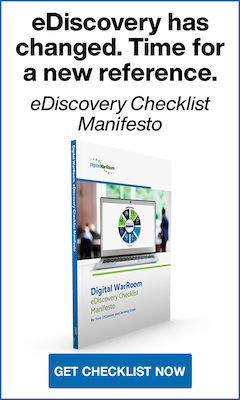Discovery is a critical phase of any trial or lawsuit, and can make the difference between a successful case and one that goes horribly awry. Both the requesting and producing party have a number of obligations to meet during the discovery process, whether this done through eDiscovery software or other discovery methods, which are extensively detailed in Federal Rule of Civil Procedure 26 (FRCP).
Litigation can become extremely complex. Imagine having to identify, collect, process, review and produce hundreds of thousands of documents in order to meet discovery obligations. Is your firm up to par in understanding the Federal Rules related to discovery? For one, ABA Model Rule 1.1 [Comment 8] prescribes a mandatory duty of technological competence, and this rule has been adopted by the vast majority of states. Not only will attorneys need to know their obligations in Rule 26 of the FRCP, but they should also consider their readiness to meet the technical requirements of the case at hand.
On any given case, attorneys may have to wade through an enormous number of electronic documents. Rule 26 itself contains numerous parts dictating how the discovery process should unfold, including what relevant information needs to be disclosed, timelines that must be adhered to, and the responsibilities of each party. Among all these requirements, if Rule 26 were to be encompassed by a single guiding theme, just know that cooperation between parties is a crucial mechanism to ensure a “Just, Speedy, and Inexpensive” resolution as outlined in Rule number 1 of the FRCP.
FRCP 26 a 1 – Initial Disclosures
FRCP 26A proscribes that the disclosing party must provide to the opposing party the following information without a pending discovery request:
- The names and contact information of any party who may have knowledge of or access to discoverable information or evidence that could support or contradict the fundamental claims of a case.
- A catalog of all electronic documents and data that will be used by either party to make its case.
- A complete breakdown of all damages sought by disclosing parties, including how those figures were determined.
- Disclosure of expert testimony – aka: “Bring your geek to court” or “Subject Matter Expert”.
All of this info should be included with your rule 26(a)(1) initial disclosures form. There may be exceptions to these rules as outlined in FRCP 26(a)(1), but in many cases, lawyers will need to disclose potentially relevant documents and discoverable information while adhering to obligations in good faith. This will include a comprehensive sweeep to identify all potentially relevant custodians and their data sources. If the data collection process becomes too technical, you may wish to hire a forensic collection expert who will have a better understanding of the data systems in question and can certify that the data was collected in a forensically sound manner (thereby preserving all metadata). Ultimately, meeting requirements set forth in FRCP 26a1 and corresponding technical obligations will be the responsibility of the attorney.
FRCP 26 b 1 – Discovery Scope and Limits
FRCP 26 b states that Parties may obtain discovery regarding any nonprivileged matter that is relevant to any party's claim or defense and proportional to the needs of the case.
eDiscovery professionals always look back to the 2006 amendments to the Federal Rules of Civil Procedure as a turning point in rules governing electronically stored information. After the adoption of these amendments, all electronically stored information (ESI) became discoverable in US litigation. The definition of electronically stored information was left intentionally broad, which leaves room for data associated with future inventions to be discoverable. One trending example: voice commands logged in an Amazon Echo.
FRCP Rule 26 b 2 b – Limits on eDiscovery, Undue Burden or Cost
A party need not provide discovery of electronically stored information from sources that the party identifies as not reasonably accessible because of undue burden or cost
The Federal Rules acknowledge the potential overwhelming burden of eDiscovery. To prevent unnecessary cost due to large data volumes or complicated collection procedures, Rule 26 (b)(2)(b) provides a framework for which both parties may negotiate a reasonable scope of the investigation. The strategy for negotiating scope may depend on several factors. Is your firm prepared to meet production deadlines of a large data set? Are you worried the other side is hiding something? What data sources or custodians could you rule out? How cost-sensitive is your client?
What is a Rule 26(f) conference?
Rule 26(f) describes a conference of the parties to cooperate and plan for eDiscovery. This conference is not necessarily held in person and is intended to be ongoing. Both parties are jointly responsible for arranging the conference, and should continuously communicate and revisit issues related to eDiscovery as they learn more details about the case and the data.
According to the exact language of Rule 26(f) - in conferring, the parties must
- Consider the nature and basis of their claims and defenses
- Consider possibilities for promptly settling or resolving the case-
- Make or arrange for the disclosures required by Rule 26(a)(1)
- Discuss any issues about preserving discoverable information
- Develop a proposed discovery plan.
What is a Proposed Discovery Plan?
FRCP Rule 26(f)(3)(c)
Among all the items mentioned, each party must create and submit their own proposed discovery plan defined in Rule 26 (f)(3)(c) which recommends several issues to consider during your 26(f) conference.
- Specific custodians to target
- Timing of discovery, deadlines
- Disclosure issues – Has the producing party identified and disclosed a satisfactory data map of potentially relevant information?
- Preservation Issues – Have all legal holds been acknowledged?
- Form of production – How should ESI be produced to the opposing party?
- Privilege issues – Agree on a procedure to assert privilege
- Include a clawback agreement under Federal Rule of Evidence 502. This allows privileged documents produced accidentally to be clawed back.
- Define the scope of discovery
We will add in one more item:
- Which eDiscovery vendor and solution you will be using to conduct these processes? Does the vendor meet your requirements? Consider: features, pricing, training/support.
Proposed discovery plans must be available in time for both sides to review in preparation for pre-trial negotiations and conferences. Attorneys representing both parties in a lawsuit come together to share those documents and agree on the precise details of the discovery process, including the scope of discovery, at the Rule 26(f) conference.
According to the Federal Rules of Civil Procedure, meet and confer conferences must be held as soon as possible, or at least 21 days before the scheduling order is due. It’s a good idea to create a Rule 26(f) checklist so you are fully prepared to meet with opposing counsel to discuss and hammer out the terms of proposed discovery.
Never commit to discovery terms without doing your research
Proposed discovery negotiations are a critical juncture in the lifecycle of a lawsuit, setting binding expectations for what stored information each side will produce. The age of electronically stored information discovery has complicated this process somewhat for attorneys who don’t feel as comfortable managing digital documents compared with physical papers. As such, they may not fully appreciate the scope of some requests the opposing party may make of them during negotiations.
Tip #1: Know your data. With proper planning, you will be more effective in negotiating the scope of the investigation and culling out the “junk”. Consult with custodians/stakeholders and perform various levels of early case assessment.
Tip #2: If you don’t have a production agreement or don’t understand the technical details in an opposing party agreement, consult an expert (which could be your eDiscovery vendor).
It’s extremely important that attorneys do not agree to discovery terms they don’t completely understand. Once negotiations are complete and those expectations are established, you may be stuck with terms that cannot be revised.
For instance, if the requesting party failed to specify requirements for a form of production, they may be on the hook to pay for professional service hours in the case that the producing party delivers unstructured data or a non-standard load file.
On the flip side, we do sometimes see eDiscovery being used as a weapon. The Federal Rules seek to reduce discovery burden and protect attorneys against overreaching discovery tactics and unrealistic requests from opposing counsel. Discovery plan proceedings are governed by some manner of negotiating agreement. Requests from the party seeking discovery need to be made in good faith and demonstrate clear purpose. For instance, the requesting party cannot insist that the producing party collect data from an unlimited number of custodians. The cost of such requests must be proportional to the value of the case.
The degree to which these agreements are formalized depends on the court order, the courts themselves and the local district rules they follow. Even so, discovery requests need to follow rules of specificity, such as asking for email communications that pertain to the specific complaint. Any discovery request for production must cover the discoverable information and matter that is relevant for that particular case. This definition and scope of relevance is one of the crucial topics which must be discussed in a 26(f) conference.
At the same time, attorneys shouldn’t narrow their focus too much when sitting down at the negotiation table and establishing discovery terms. Agreeing to narrow discovery parameters could prevent lawyers from using key leverage during their case because it was excluded from consideration at the outset of discovery. ESI discovery negotiations can be tricky in this regard if lawyers are unfamiliar with the logistics of data preservation and production and what constitutes a reasonable request.
It’s up to each attorney to recognize that Rule 26 measures are in place to protect their interests at the negotiating table, and require the parties to act in good faith. They don’t necessarily have to agree to unreasonable terms. The discovery dispute and negotiation process is, after all, a critical part of pretrial strategy, with both sides trying to get a competitive edge over the other.
Doing your research and due diligence to fully understand the scope of a case will insulate lawyers against fishing expeditions and help counter frivolous or vague complaints lodged by the opposing counsel.
Use a FRCP Rule 26(f) checklist
Digital WarRoom highly recommends the use of checklists to guide your 26(f) conference and discovery proceedings. Checklists are designed to be your concrete, action items to make sure you don’t forget anything. Given the complexity of eDiscovery, a well-prepared checklist will be your best friend to ensure you consider each step. We went ahead and created our own checklist – the eDiscovery Checklist Manifesto.
The Checklist Manifesto defines a set of unique tasks which are typical to the eDiscovery workflow – identify, collect, process, review, produce, etc. More importantly legal professionals will be consistently managing three common tasks – Budget, Risk & Strategy.
Attorneys need to be very strategic when compiling a new discovery plan while following Rule 26 guidelines. The vast majority of lawsuits - by some accounts, as many as 95% - are settled before going to trial. Discovery plays a major role in the legal maneuvering that occurs throughout pretrial phases and can ultimately determine how a lawsuit is settled and which side comes out on top. Having a robust discovery plan in place can help lawyers win or settle based on irrefutable strength of their evidence.
While large law firms likely have teams dedicated to producing discovery plans and documents, small or midsized law firms won’t be so lucky. Discovery tasks, such as document review, production, and preservation, may need to be carried out by a single attorney, paralegal, or litigation support professional. With more limited resources, attorneys at these law firms need to balance their individual case objectives with maintaining manageable workloads. No one wins when lawyers spread themselves too thin.
Attorneys must keep the proportionality of each case in mind when conducting discovery proceedings. Spending dozens of billable hours painstakingly managing metadata on a simple commercial real estate dispute, for instance, will produce diminishing returns.
Importance of discovery preparation
Establishing reasonable expectations goes a long way toward minimizing the headaches lawyers must endure adhering to ESI protocols, Rule 26 and other discovery regulations. It’s important to keep in mind that there is a pretty thin threshold to meet in order to avoid failure-to-preserve sanctions. Simply demonstrating an honest effort was made to comply with preservation demands is often enough evidence to avoid claims of negligence and satisfy governing bodies.
Doing your due diligence will also help address any discovery dispute that may come up, such as the opposing party filing a motion to compel if they believe produced data is insufficient.
When approaching your discovery plan, think of your case like a painting or other work of art. It’s more than just the sum of its parts, whether you’re talking about paint and plaster in artwork or data and documentation in a lawsuit. Visualize what a successful argument looks like and what specific evidence you will need to convince a judge or jury. From there, you can start to map out what documents you will need to produce and which witnesses will need to give depositions. If you start with a clear end result in mind, you can pare down the amount of data and documentation needed to support your case.
How to streamline your discovery plan and address FRCP Rule 26
The easiest way to adhere to discovery obligations and grow your practice without spending an enormous amount of energy and time (ie, billable hours) hunting down documents, preserving them, and producing copies for civil procedure is to take advantage of eDiscovery tools and their included benefits.
Using eDiscovery software will help automate and accelerate various aspects of the discovery process. Using an eDiscovery tool is an important step to meet legal obligations and ties in closely with the duty of technological competence. Using document review software like Digital WarRoom will allow legal professionals to seamlessly cull data, produce documents to meet obligations, and minimize operational costs.
Digital WarRoom’s cloud-based eDiscovery solution enables attorneys to quickly and easily load data using simple drag-and-drop interfaces, making data processing incredibly straightforward and simple. Metadata extraction is automated, and can be managed by the user without the need for a third party to intervene. The processing interface also indexes words contained in cataloged documents, meaning that all documents are keyword readily searchable. OCR is also available to index words within a scanned document, TIF, PDF or image.
With Digital WarRoom eDiscovery software, attorneys can accelerate discovery procedures, meet legal obligations, and construct the most persuasive case possible.
To find out more about meeting every requirement laid out in Rule 26, as well as developing a successful discovery plan, review Digital WarRoom’s comprehensive eDiscovery Checklist Manifesto. If you want to experience time- and cost-savings of eDiscovery software for yourself, contact Digital WarRoom today or schedule a 1 hour product demonstration.
If you found this article interesting, be sure to subscribe you and your team to our monthly blog distribution email. This email list is solely for blog distribution purposes and we promise to only send one email per month. To subscribe, simply scroll down and fill out the "Subscribe" form below the comment box.
-1.png?width=400&height=164&name=DWRLogoClassic%20-%20Copy%20(2)-1.png)









Comment On This Article